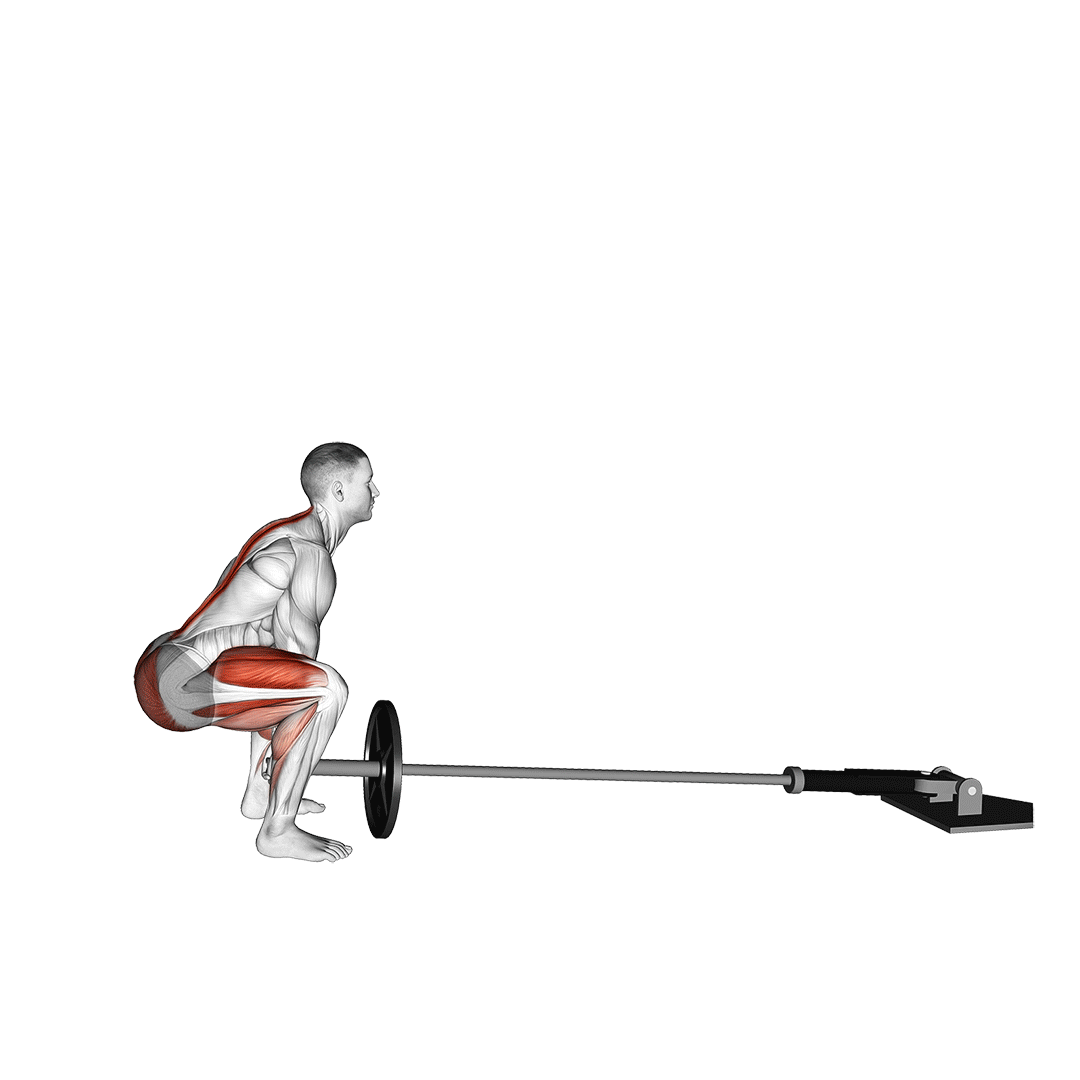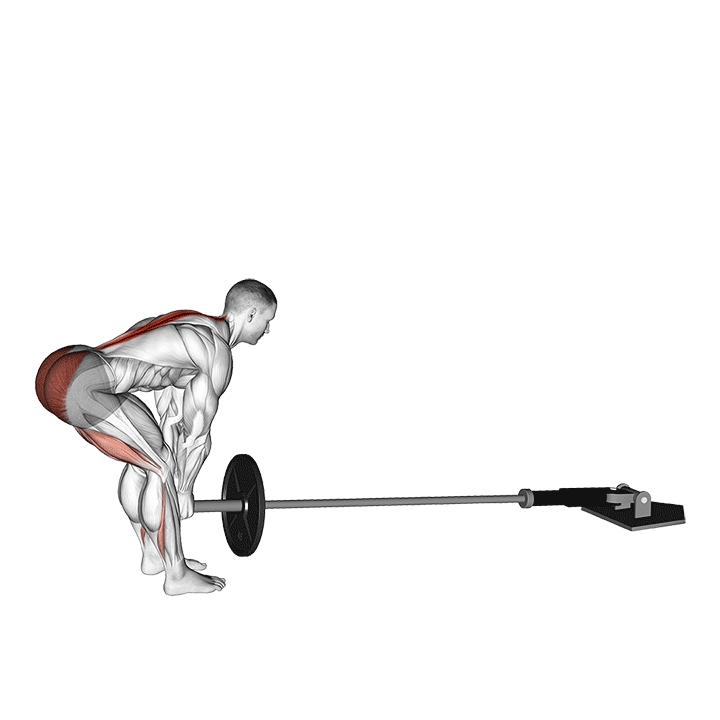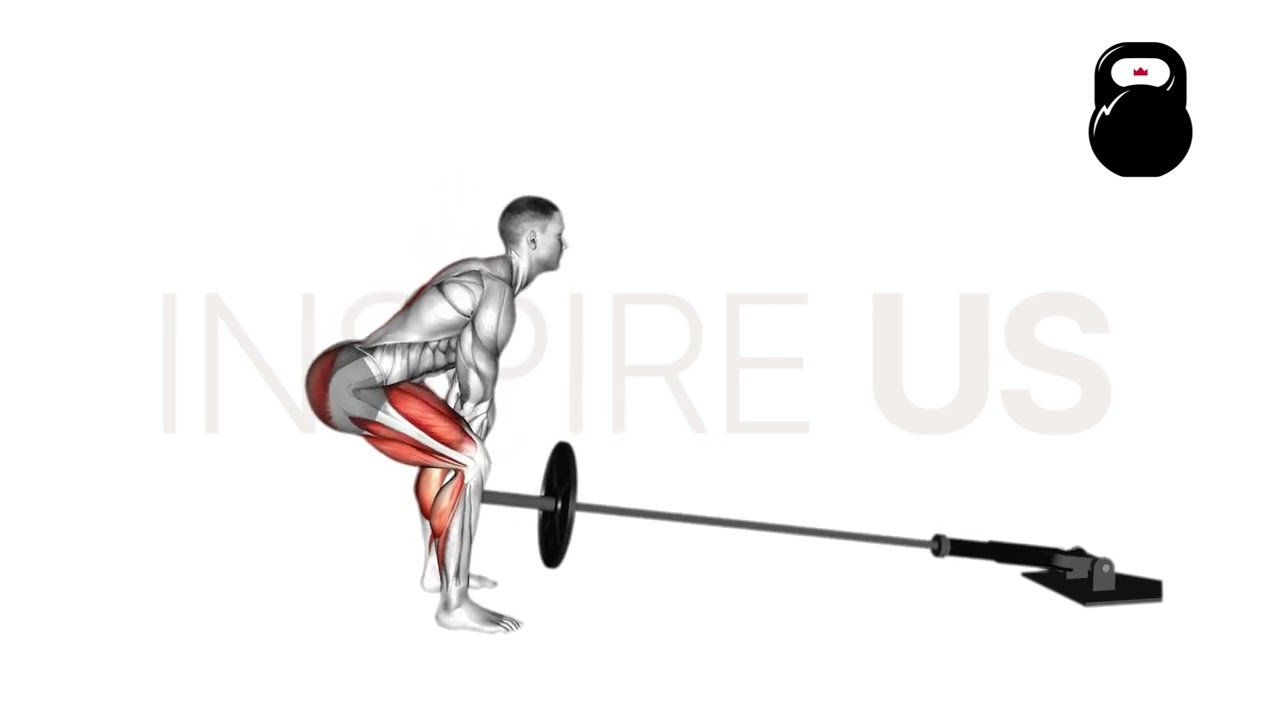Landmine Deadlifts: Muscles Worked and More
The landmine deadlift is a variation of barbell deadlift performed so as to reduce strain on the lower back and create a comparatively unique bar path.
Apart from these advantages, conventional and landmine deadlifts remain much the same in that they are primarily a posterior chain compound movement for building strength and power.
What are Landmine Deadlifts?
The landmine deadlift is a free weight compound movement involving one end of a barbell being placed in a landmine apparatus with the other gripped in both of the lifter’s hands - where they perform an otherwise ordinary deadlift.

In actual practice, the landmine deadlift is used as either a safer alternative to the aforementioned conventional deadlift, or simply as a method of building lower body strength and explosiveness in a convenient and back-friendly manner.
Landmine deadlifts (like other deadlift variants) are meant to be considerably heavy and intense, and as such it is best to first master the conventional or sumo deadlift prior to attempting the landmine variant.
How to do Landmine Deadlifts
In order to perform a repetition of the landmine deadlift, the lifter will first insert one end of a barbell into a landmine attachment.
If no landmine apparatus is present, wedge the barbell’s end beneath a sufficiently low and heavy object, such as a heavy resistance machine or several weight plates.
With the barbell now secured to the floor, the lifter loads the end nearest them with a moderate to heavy load, holding it in both hands using a neutral grip.
The repetition should begin with the knees somewhat bent, torso hinged forward at the hips with the arms beneath the torso as they hold the barbell. The feet should be wider than hip-width apart, the chest pushed out and the scapula depressed towards the hips.
Now in the correct position, the lifter rapidly extends their knees and pushes their hips forwards by contracting their glutes. This should position the lifter upright with the end of the barbell held near hip-level, detached from the body rather than pulled against it like with a regular deadlift.
Once standing upright, the lifter then slowly lowers the barbell once more by bending their knees and hinging at the hips - lowering the bar back towards the floor in a controlled manner. At this point, the repetition is considered complete.
Remember to brace the core throughout the movement and ensure the back remains relatively flat and neutral. The lower back should not round at any point during the repetition.
Sets and Reps Recommendation:
Landmine deadlifts are considerably intense when performed with sufficient load.
Novices or those unfamiliar with the landmine deadlift should aim for 4 sets of 5 repetitions each.
More advanced weightlifters can up intensity and reduce volume by dropping to 3 sets of 5 repetitions, or increase volume by aiming for 4-5 sets of 6-8 repetitions instead.
What Muscles do Landmine Deadlifts Work?
Landmine deadlifts are what is known as a compound movement, meaning multiple joints are involved - of which subsequently also equates to multiple muscles being contracted in concert.

These muscles are further divided according to the role they play within the exercise.
“Mover” or “mobilizer” muscles are those that contract dynamically, exerting the most force and also receiving the most benefit from the landmine deadlift.
In contrast, “stabilizer” muscles are those that contract in place (isometric contraction), aiding with stabilizing the load and the body itself.
Mover Muscles
Landmine deadlifts are primarily a posterior chain exercise, hence the fact that the primary mover muscles are the glutes and hamstrings along the lower posterior section of the body.
In addition to these is the quadriceps femoris, which acts as a secondary mover due to its shorter range of motion and somewhat weaker level of activation during the exercise.
Stabilizer Muscles
Alongside the mover muscles, the spinal erectors, core, trapezius and forearms all contract isometrically to aid with the movement as well.
Common Landmine Deadlift Mistakes to Avoid
While the landmine deadlift is indeed one of the safest forms of deadlift, avoid the following mistakes to further reduce any risk of injury present.
Rounding the Back
The most important mistake to correct is any sort of noticeable rounding of the back. Throughout the entire landmine deadlift set, the back should form a relatively flat line with the spine and lower back kept as neutral as possible.
Failing to keep proper back curvature can lead to generally poor strength output and injuries of the spinal erectors or even the spine itself.
Some rounding of the upper back is permissible, so long as the scapula remains depressed and the middle or lower back is neutral.
In order to ensure the back does not round, the lifter should aim to correctly brace their core, hinge by pushing the hips back (rather than bending at the waist) and to push the chest out as they pull the bar.
Poor Hip Positioning
Apart from checking for poor back curvature, the lifter should also assess whether their starting hip position is disadvantageous.
Generally, the hips should be below the lower back but above the knees by several inches, providing an advantageous position for the posterior chain muscles but not causing lower back rounding or turning the movement into a squat.
If the hips are too low, the quadriceps and knees will be forced to bear more of the bar’s weight - whereas too high may cause the torso to hinge further forwards and potentially strain the lower back.
Curving Neck or Turning Head
To avoid straining the neck or its underlying cervical spine, the lifter should avoid turning their head in any direction as they perform a landmine deadlift. Likewise, they should also avoid extending or flexing the neck excessively.
Instead, the eyes should be fixed on a point several feet away, with the head facing in the same direction as the torso and the neck kept in a neutral position as well.
Curling the Bar or Bending Elbows
Another mistake to avoid during a landmine deadlift set is dynamic contraction of the elbow flexor muscles.
With the sheer amount of weight loaded onto the barbell, failing to keep the arms fully extended throughout each repetition can cause the biceps, brachialis or brachioradialis to bear a significant amount of this load - leading to tears and other injuries, especially if an underhand grip is utilized.
Remember that the landmine deadlift is primarily a lower body exercise, and the muscles of the arms are not meant to be involved in any significant capacity. Avoid “curling” the bar by bending at the elbows.
Variations of the Landmine Deadlift
If the conventional landmine deadlift doesn’t quite hit your posterior chain correctly, try the following alternative variations out.
Landmine Romanian Deadlifts (RDL)
Landmine Romanian deadlifts are a more posterior chain focused variation of the conventional landmine deadlift.

Rather than bending at the knees, the Romanian variant aims to involve as little knee flexion as possible and to instead derive the majority of strength from the hamstrings and glutes.
While this indeed shrinks the number of muscles worked and reduces loading capacity, it more than makes up for it with a larger hamstring range of motion and an overall greater focus on hypertrophy.
Landmine Suitcase Deadlifts
For a more unilateral form of landmine deadlift, lifters can try facing sideways as they pull the end of the barbell off the floor.
While more advanced and more likely to result in injury, landmine suitcase deadlifts are used by experienced weightlifters to help correct muscular imbalances, improve stability while deadlifting and improve their overall unilateral strength.
Only perform landmine suitcase deadlifts if you have already mastered conventional deadlifts, and have an explicit need for them in your training program.
Single-Leg Landmine Deadlifts
Because of the greater balance afforded by using a landmine apparatus for deadlifts, many lifters choose to take advantage and seek to build their unilateral strength on each side.
The easiest way to do so is to simply perform deadlifts with one leg elevated backwards into the air, the working leg facing towards the side of the bar.
Apart from building balance and one-side strength, the single-leg landmine deadlift is also used for correcting asymmetries in muscle groups or in general deadlift technique.
Frequently Asked Questions (FAQ)
Are Landmine Deadlifts Good?
Yes - landmine deadlifts are excellent, especially for individuals that have been advised to reduce strain on their lower back during training.
Landmine deadlifts target much the same muscle groups as conventional deadlifts to a similar level of intensity, meaning that they also offer a similar range of advantages.
Can You Do RDL With a Landmine?
Yes! The landmine Romanian deadlift is in fact somewhat more commonly performed than conventional landmine deadlifts, as the angle of the bar and unique range of motion are far more conducive to proper hamstring contraction.
Are Landmine Deadlifts Bad for Your Back?
Not at all. Landmine deadlifts are comparatively safer for the back than other forms of deadlift. This benefit comes as a result of the bar’s path when pulled from the floor, and the fact that the lifter will be able to better hinge their hips due to the bar’s position away from the body itself.
References
1. Weaver, Ashley & Kerksick, Chad. (2017). Implementing Landmine Single-Leg Romanian Deadlift into an Athlete's Training Program. Strength and Conditioning Journal. 39. 85-90. 10.1519/SSC.0000000000000279.
2. Bird, Stephen & Barrington-Higgs, Benjamin. (2010). Exploring the Deadlift. Strength and Conditioning Journal - STRENGTH CONDITIONING J. 32. 46-51. 10.1519/SSC.0b013e3181d59582.
3. Contreras, Bret., Cordoza, Glen. (September 17, 2019) Glute Lab: The Art and Science of Strength and Physique Training. United States: Victory Belt Publishing, 2019. ISBN: 9781628603460, 1628603461

